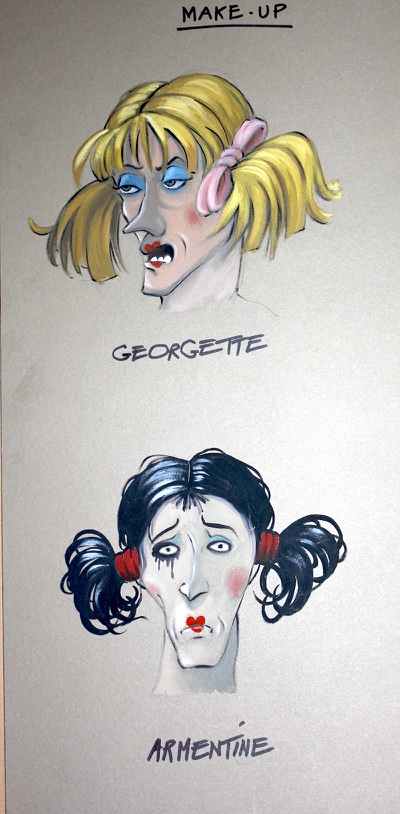
Spencer Novich (left) and Brett Alters pose with props and costumes for their original production “Two Little Girls in the Bayou.” The pair used the crowd-funding website Kickstarter to raise $10,000 for the production.
Wednesday, Sept. 5, 2012 | 2 a.m.
This is the first in an occasional series of stories on the birth of a Las Vegas show.
In a town where multimillion-dollar productions are the benchmark of entertainment, two little-known performers — they are clowns, at opposite ends of the Strip — are trying to launch their own show.
They’ve developed character sketches and costumes designs, and plastic props, synthetic wigs and hand-sewn costumes are scattered about in their Henderson home. They’re simple compared to the lavish costumes they wear in “Le Reve” and “Ka,” but these guys are, after all, on a budget when it comes to creating their own show.
Indeed, the biggest challenge facing Brett Alters and Spencer Novich is raising the money to bankroll their dream.
Vegas may be famous for its shows, but not for its deep-pocket investors. This isn’t Broadway.
But that isn’t stopping them.
“In our society and this economy, you have to make things happen yourself,” Alters says.
That’s why he’s not buying durable furniture that won’t break when he sits on it. “Something in my head says, ‘No, you need to spend money on accessories for a costume. You need to buy clay to make a mask.’”
On this day, they’re wondering how they’re going to raise the $20,000 they need to turn their vision into staged reality.
• • •
Alters, 25 and Novich, 24 began performing as clown duo in 2006, when they met as theater students at New York University’s Tisch School of the Arts. After graduating, they found work in top-tier Vegas shows — Alters as a clown in the Wynn’s aquatic show “Le Reve” and Novich as the villainous counselor’s son in Cirque du Soleil’s “Ka” at the MGM Grand.
At the same time, the pair continued to perform their brand of theatrical physical comedy in short variety showcases organized by and for local entertainers, honing their art until they decided it was time to pursue their own full length, professional quality show.
The result is “Two Little Girls in the Bayou,” an hour long theatrical revue that’s equal parts dark comedy and physical spectacle, about two orphaned sisters and their survival guide to life in the Southern swamps (audiences can expect to be enlightened on topics ranging from capturing alligators to “purposeful drowning”).
In Las Vegas, the story of performers striving to break out on their own is far from new or unique. However, the glamorous tale of stepping out of the chorus and becoming an overnight sensation is a myth belying the reality of performers like Alters and Novich.
Rather, it’s a step-by-step business process, one that during the past 12 months they’ve more or less managed to master.
When they brought their idea to Loppo Martinez, former artistic development director of the Franco Dragone Entertainment Group, whom Alters knows from the local theater community, the creative chemistry was immediate. Martinez agreed to be the show’s artistic director and composer, and soon the three had looped in a team of industry veterans that includes a props concepteur and performance coach, a director of photography, and a choreographer.
“There’s always so many ideas floating around in everybody’s heads, but they only come together once you get the right puzzle of creative people like this,” Alters said, explaining that the team commitment helps keep Novich and him accountable to follow through with the project. “We’ve been on a lot of creative teams where people sit around and they talk about projects they’re going to do, and then the project sits for years because they’re looking for money, or for people to commit the time. In our situation, we sat down and they said, ‘We’re going to commit the time,’ so we said we’ve got to commit the money or it’s not going to happen.”
When Alters and Novich went forward with planning the production, they estimated their budget at around $3,000. It turned out that was just the cost of props and equipment.
They quickly learned how deep the rabbit hole of professional-level show production runs. In addition to paying their production team, they had to commission original music, rent a theater, pay startup fees and establish themselves as a limited liability company with a corporate bank account and insured contracts.
Total cost: $20,000, an amount so small in the world of financial backers of multi-million dollar Vegas spectacles that Alters and Novich didn’t even bother approaching them.
“If we came to a Vegas producer with an idea for a show with a $20,000 budget, we’d get laughed at,” Novich said.
He suspects that in New York, with its rich, diverse culture of theater, they may have been able to find an investor for “Two Little Girls.” But in Las Vegas, with its large-scale mainstream mentality, there was simply no context or precedent for an independent, off-beat production like theirs.
“It’s a scary market to enter because art often gets pushed aside for pyrotechnics,” Novich said.
After investing $12,000 of personal savings, the pair turned to the crowd-funding website Kickstarter to raise the remaining $10,000. Kickstarter helps fund creative projects via the collective effort of individuals pledging money toward a cause or idea.
Each project must be approved by Kickstarter before it can launch a campaign page on the website, through which people can make financial contributions. Project founders like Alters and Novich can garner momentum by promoting the campaign through social media like Facebook, Twitter and YouTube.
There are several crowd-funding websites around, but Kickstarter comes with a caveat that ups the pressure: It’s driven by an all-or-nothing method in which projects must raise their goal amount in a certain period of time or no money is received.
The carrot to that stick is project-related pledge incentives. In the case of “Two Little Girls,” individuals who pledged $5 will have their name appear in the show credits; those who pledged $25 get their name in the credits and a ticket to the show. As pledge increments increase, so do the reward incentives: those who pledge $500, for example, will receive four VIP tickets to the show and the opportunity to sit in on a closed rehearsal of the show.
Alters and Novich aren’t the first members of the local arts community to use crowd-funding. The local theater group Cockcroach Theater was able to open downtown’s Art Square Theatre as its new home this summer thanks to $20,000 raised on the crowd-funding website IndieGoGo.com; local artist Jerry Misko used Kickstarter to raise over $10,000 in June to help fund a downtown mural project; and the Burlesque Hall of Fame successfully completed a $20,000 IndieGoGo campaign on Aug. 31 to relocate its collection after its current facility was seized under eminent domain.
Alters and Novich are, however, the first to use Kickstarter to directly fund a theatrical production. For them, an added benefit of crowd-funding is being able to maintain their artistic integrity, free from the strings of profit-hungry producers and spectacle-pandering that might come attached to a traditionally-funded Vegas show.
“People who give on Kickstarter have no other motives than just wanting to see the project get made,” Novich says. “They don’t expect anything except to get to see a show. This is literally people funding the arts.”
Their campaign, which ran from Aug. 9 through Monday, was a month of slow but steady progress. Novich and Alters harnessed the power of social media, managing a Facebook fan page for the production, sending mass emails and posting promos and preview videos of “Two Little Girls” on YouTube. Friends and family also heavily promoted the campaign through social media, resulting in a significant number of pledges coming in from acquaintances and third party connections.
Four days before the deadline, the campaign was $2,000 within its goal, an amount close enough to get hopes up but large enough to let the nail biting begin.
“I just kept talking to friends who had run successful Kickstarters to stay optimistic,” Novich said. “I used them to stabilize myself so I wouldn’t completely freak out.”
Late Saturday night, Novich’s phone pinged with an alert from his Kickstarter app: they met their $10,000 goal, two days ahead of schedule.
Rather than celebrate, however, the real tension kicked in. Several days before, Novich noticed that a backer had rescinded a pledge, an option available to all project backers until the end of the campaign. What if, in the hours leading up to the deadline, someone else reconsidered a contribution? At $10,012, it wouldn’t take more than someone’s penny-pinching change of heart to bring the whole project to its knees.
“Of course I was blown away that we had made it, but I was hesitant to rejoice because I knew we needed to have a buffer zone above the $10,000 to be safe,” Novich said.
Novich sat glued to the page, constantly refreshing the screen, while Alters covertly scrambled at work to write and send thank you letters to the most recent contributors. By Monday afternoon, all they could do was stare and wait as the minutes ticked down to 3 p.m. When the timer on the Kickstarter page hit zero, the project had 144 backers and $10,426. Finally, they could breathe easy.
“It was such an ordeal, I was so elated, all I could do is sigh with relief,” Alters says.
Funding the production was less about deep pockets than populism: most pledges fell in the modest range of $25 to $100 dollars, largely from friends, family and acquaintances. The largest contribution, a total $1,100 — which included the $600 that pushed them over the $10,000 mark — came from a stranger.
“It really opens your eyes to the impression you make on other people. I’m very moved,” Novich said.
• • •
Now it’s time for Alters and Novich to focus on giving their backers their money’s worth. They’ve already got a hefty to-do list prepared for the week, including locking down a performance schedule for December and January, finalizing their off-Strip performance space and calculating the costs of operating the show — and that’s just on the production side. In addition, they’ll drill scenes together, hold three full-crew rehearsals and work on sound effects and costumes.
The biggest challenge, however, will be marketing the show. Their initial run will feature shows at 12:30 a.m. and 2 p.m. — which allows them to accommodate their regular work schedules; at those hours, finding an audience of about 200 to fill seats in an off-Strip theater isn’t exactly as simple as putting up posters and passing out flyers.
“At 12:30 people are either out drinking or at home with their kids,” Alters said. “The huge thing we have to worry about is figuring out who and how to get people to come to see it when initially it’s going to be running late at night and we’re not at a casino.”
It may sound daunting, but then again, so did raising $10,000 in less than a month.
“It’s like, oh great, now we have more time to worry about the venue, now we have to worry about the schedule,” Novich joked. “Brett and I are pretty big worriers. Now it’s time to make sure the show is worthy of the budget.”
Follow Andrea Domanick on Twitter at @AndreaDomanick and fan her on Facebook at Facebook.com/AndreaDomanick.



Join the Discussion:
Check this out for a full explanation of our conversion to the LiveFyre commenting system and instructions on how to sign up for an account.
Full comments policy